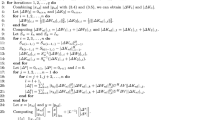Abstract
LetB be anm×n (m≥n) complex (or real) matrix. It is known that there is a uniquepolar decomposition B=QH, whereQ*Q=I, then×n identity matrix, andH is positive definite, providedB has full column rank. Existing perturbation bounds suggest that in the worst case, for complex matrices the change inQ be proportional to the reciprocal ofB's least singular value, or the reciprocal of the sum ofB's least and second least singular values if matrices are real. However, there are situations where this unitary polar factor is much more accurately determined by the data than the existing perturbation bounds would indicate. In this paper the following question is addressed: how much mayQ change ifB is perturbed to\(\tilde B = D_1^* BD_2 \), whereD 1 andD 2 are nonsingular and close to the identity matrices of suitable dimensions? It is shown that for a such kind of perturbation, the change inQ is bounded only by the distances fromD 1 andD 2 to identity matrices and thus is independent ofB's singular values. Such perturbation is restrictive, but not unrealistic. We show how a frequently used scaling technique yields such a perturbation and thus scaling may result in better-conditioned polar decompositions.
Similar content being viewed by others
References
J. Barlow and J. Demmel,Computing accurate eigensystems of scaled diagonally dominant matrices, SIAM J. Numer. Anal., 27 (1990), pp. 762–791.
A. Barrlund,Perturbation bounds on the polar decomposition, BIT, 30 (1990), pp. 101–113.
C.-H. Chen and J.-G. Sun,Perturbation bounds for the polar factors, J. Comp. Math., 7 (1989), pp. 397–401.
J. Demmel and W. Gragg,On computing accurate singular values and eigenvalues of matrices with acyclic graphs, Linear Algebra Appl., 185 (1993), pp. 203–217.
J. Demmel and W. Kahan,Accurate singular values of bidiagonal matrices, SIAM J. Sci. Stat. Comput., 11 (1990), pp. 873–912.
N. J. Higham,Computing the polar decomposition-with applications, SIAM J. Sci. Stat. Comput., 7 (1986), pp. 1160–1174.
W. Kahan,Accurate eigenvalues of a symmetric tridiagonal matrix, Tech. Report CS41, Computer Science Department, Stanford University, Stanford, CA, 1966 (revised June 1968).
C. Kenney and A. J. Laub,Polar decomposition and matrix sign function condition estimates, SIAM J. Sci. Stat. Comput., 12 (1991), pp. 488–504.
F. Kittaneh,Inequalities for the schatten p-norm. III, Comm. Math. Phys., 104 (1986), pp. 307–310.
R.-C. Li,A perturbation bound for the generalized polar decomposition, BIT, 33 (1993), pp. 304–308.
R.-C. Li,Relative perturbation theory: (II) eigenspace and singular subspace variations, Tech. Report UCB//CSD-94-856, Computer Science Division, Department of EECS, University of California at Berkeley, 1994 (revised January 1996 and April 1996).
R.-C. Li,New perturbation bounds for the unitary polar factor, SIAM J. Matrix Anal. Appl., 16 (1995), pp. 327–332.
J.-Q. Mao,The perturbation analysis of the product of singular vector matrices UV H J. Comp. Math., 4 (1986), pp. 245–248.
R. Mathias,Perturbation bounds for the polar decomposition, SIAM J. Matrix Anal. Appl., 14 (1993), pp. 588–597.
J.-G. Sun and C.-H. Chen,Generalized polar decomposition, Math. Numer. Sinica, 11 (1989), pp. 262–273. In Chinese.
Author information
Authors and Affiliations
Additional information
This material is based in part upon work supported, during January, 1992–August, 1995, by Argonne National Laboratory under grant No. 20552402 and by the University of Tennessee through the Advanced Research Projects Agency under contract No. DAAL03-91-C-0047, by the National Science Foundation under grant No. ASC-9005933, and by the National Science Infrastructure grants No. CDA-8722788 and CDA-9401156, and supported, since August, 1995, by a Householder Fellowship in Scientific Computing at Oak Ridge National Laboratory, supported by the Applied Mathematical Sciences Research Program, Office of Energy Research, United States Department of Energy contract DE-AC05-96OR22464 with Lockheed Martin Energy Research Corp.
Rights and permissions
About this article
Cite this article
Li, RC. Relative perturbation bounds for the unitary polar factor. Bit Numer Math 37, 67–75 (1997). https://doi.org/10.1007/BF02510173
Received:
Issue Date:
DOI: https://doi.org/10.1007/BF02510173



